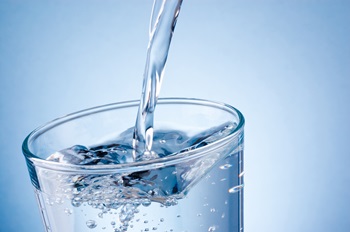<p>By Dr. Shelby Furman, Director, Food and Product Safety Programs, FMI </p><p><img src="https://www.fmi.org/images/default-source/blog-images/water-pouring-into-glass.tmb-large-350-.jpeg?Culture=en&sfvrsn=cd95b64b_1" style="margin-bottom:10px;float:right;margin-left:10px;" alt="Water Pouring Into Glass" class="-align-right" sf-size="1336593" />From brushing our teeth, making coffee, to washing our dishes, everyone uses water every day to live healthy lives. As individuals, we expect water from public water systems to be safe for use. Businesses also rely on water for everything from food production to sanitation and must shift practices or even shut down operations without access to potable water. <span style="background-color:transparent;color:inherit;font-family:inherit;font-size:inherit;text-align:inherit;text-transform:inherit;word-spacing:normal;caret-color:auto;white-space:inherit;"> </span></p><p>It is essential to ensure that water that is consumed is safe and free of contaminants. A contaminant in drinking water is defined as anything other than water molecules. These can be classified in four ways: physical, chemical, biological and radiological. Though not all contaminants in water are considered harmful, some contaminants have potential health effects and have been or are starting to be regulated by the U.S. Environmental Protection Agency (EPA).<span style="background-color:transparent;color:inherit;font-family:inherit;font-size:inherit;text-align:inherit;text-transform:inherit;word-spacing:normal;caret-color:auto;white-space:inherit;"> </span></p><p>Of the standards set by the EPA, there is one regulation in particular that has made headlines recently: the <a href="https://www.epa.gov/ground-water-and-drinking-water/national-primary-drinking-water-regulations" target="_blank">National Primary Drinking Water Regulations (NPDWR)</a>, which are legally enforceable standards and treatment methods that apply to public water systems (PWS). This regulation is intended to protect public health by limiting the levels of contaminants in public drinking water, such as microorganisms, disinfectants and inorganic/organic chemicals.<span style="background-color:transparent;color:inherit;font-family:inherit;font-size:inherit;text-align:inherit;text-transform:inherit;word-spacing:normal;caret-color:auto;white-space:inherit;"> </span></p><p>A set of contaminants that are of particular interest are chemicals known as per- and polyfluoroalkyl substances (PFAS). These substances are man-made chemicals that are used for their water, oil and grease resistance properties. However, they also do not break down easily and have the ability to accumulate in the environment and the body, leading to a growing concern over their potential health effects.<span style="background-color:transparent;color:inherit;font-family:inherit;font-size:inherit;text-align:inherit;text-transform:inherit;word-spacing:normal;caret-color:auto;white-space:inherit;"> </span></p><p>In April 2024, the EPA announced final regulations on six PFAS and established health-based, non-enforceable Maximum Contaminant Level Goals (MCLGs) that range from 0-10 parts per trillion (ppt): </p><ul><li>PFOA (Perfluorooctanoic Acid)</li><li>PFOS (Perfluorooctane sulfonic acid)</li><li>PFHxS (Perfluorohexane sulfonate)</li><li>PFNA (Perfluorononanoic acid)</li><li>HFPO-DA (Gen-X chemicals)</li><li>Mixture containing two or more of PFHxS, PFNA, HFPO-DA, and PFBS (Perfluorobutane sulfonic acid)</li></ul><p>EPA also finalized legally enforceable Maximum Contaminant Levels (MCLs) that are more easily achievable, which range from 4-10 ppt. As a part of the regulation, by 2027, public water systems must have completed initial monitoring for the listed PFAS. The water systems must also provide the levels of PFAS in their drinking water beginning in 2027. By 2029, water systems must implement solutions to reduce the monitored PFAS if they exceed the Maximum Contaminant Levels. Beginning in 2029, public water systems that violate one or more of the MCLs must take action on reducing the level of PFAS in the water supply and must notify the public of such violation.</p><h5><strong>What impact does the NPDWR have on the food industry?</strong><strong></strong></h5><p>With this regulation, FMI members might have some questions about what this means for their operations. The ruling specifically regulates public water systems and does not require action from the food industry at this time. That said, operations relying on PWS should work cooperatively with utility officials to ensure compliance and uninterrupted service at their facilities. Food facilities have the responsibility to ensure the use of water that is safe and of adequate quality in their operations to comply with U.S. Food and Drug Administration Good Manufacturing Practice (GMP) requirements. FDA considers using water that meets the standards for household drinking water would also be acceptable for the production of food products, and facilities can rely on the standards in EPA’s NPDW regulations to satisfy the GMP requirements.<span style="background-color:transparent;color:inherit;font-family:inherit;font-size:inherit;text-align:inherit;text-transform:inherit;word-spacing:normal;caret-color:auto;white-space:inherit;"></span></p><h5><strong>What impact does the NPDWR have on bottled water?</strong><strong></strong></h5><p>Bottled water is regulated by the FDA; therefore, EPA’s rule does not apply directly. Currently, FDA has not established standards for PFAS in bottled water. Because EPA has finalized these standards, FDA is now required to evaluate what PFAS standards are appropriate. The agency is in its initial phase of research and is currently conducting a targeted survey for PFAS in bottled water. Results from its 2016 targeted survey did not detect PFAS in bottled water.<span style="background-color:transparent;color:inherit;font-family:inherit;font-size:inherit;text-align:inherit;text-transform:inherit;word-spacing:normal;caret-color:auto;white-space:inherit;"></span></p><p>FMI will continue to monitor regulatory changes and the impact on the food industry and will update our members promptly with any new information.</p><h5><strong>Resources</strong><strong></strong></h5><ul><li><a href="https://www.fmi.org/food-safety/food-safety-resources/backgrounders/background-information/food-safety-backgrounders/2024/04/24/per–and-polyfluoroalkyl-substances">Per- and Polyfluoroalkyl Substances (PFAS) FMI Backgrounder</a></li><li><a href="https://www.epa.gov/sdwa/and-polyfluoroalkyl-substances-pfas" target="_blank">Final PFAS National Primary Drinking Water Regulation</a></li><li><a href="https://www.epa.gov/system/files/documents/2024-04/pfas-npdwr_fact-sheet_treatment_4.8.24.pdf" target="_blank">Fact Sheet: Treatment Options for Removing PFAS in Drinking Water</a></li><li><a href="https://www.epa.gov/system/files/documents/2024-04/pfas-npdwr_fact-sheet_cost-and-benefits_4.8.24.pdf" target="_blank">Fact Sheet: Benefits and Costs of Reducing PFAS in Drinking Water</a></li><li><a href="https://www.govinfo.gov/content/pkg/FR-2015-09-17/pdf/2015-21920.pdf" target="_blank">Current Good Manufacturing Practice, Hazard Analysis, and Risk-Based Preventive Controls for Human Food</a><span style="text-decoration:underline;"></span></li></ul>
[#item_full_content]



